If you’ve ever walked into a room filled with green plants, you know how instantly calm and alive it feels. The good news? You don’t need a big garden, fancy tools, or expert skills to enjoy that same feeling at home. A few indoor plants can transform your space and even make you feel healthier.
But here’s the challenge: when you’re just starting out, it’s hard to know which plants are easy to grow and which ones demand constant attention. That’s why I’ve put together this simple guide to the best indoor plants for beginners.
These are plants I’ve grown in my own nursery and recommended to countless new plant parents. They’re not only tough and low-maintenance but also beautiful. Some can clean your air, some are safe around pets, and others can survive if you occasionally forget to water them.
By the end, you’ll know exactly which plant to pick for your lifestyle and how to keep it thriving. Let’s dive into the green world of the best indoor plants and find your perfect match.
10 Best Indoor Plants for Beginners
When you’re new to houseplants, the first question is usually: “Which one is right for me?” The answer depends on your light, your routine, and sometimes even whether you have pets at home.
Here’s a simple chart that compares some of the best indoor plants for beginners. Think of it as a cheat sheet — you can come back to this anytime.
| Plant Name | Difficulty | Light Needs | Watering Frequency | Pet-Safe? | Best Placement |
|---|---|---|---|---|---|
| Snake Plant | Very Easy | Low–bright, indirect | Every 3–6 weeks | No | Bedroom, office corner |
| Pothos (Money Plant) | Easy | Low–bright, indirect | Once soil feels dry | No | Hanging pots, shelves |
| ZZ Plant | Very Easy | Low–medium, indirect | Every 2–3 weeks | No | Hallways, low-light spots |
| Spider Plant | Easy | Bright, indirect | Weekly or when dry | Yes | Bathrooms, kitchens, hanging pots |
| Peace Lily | Easy | Medium–low, indirect | Weekly (keep moist) | No | Living rooms, shaded corners |
| Aloe Vera | Easy | Bright, indirect | Every 2–3 weeks | No | Sunny windowsill, kitchen |
| Areca Palm | Moderate | Bright, indirect | Weekly (mist leaves) | Yes | Living room, hallways, balconies |
| Monstera | Moderate | Bright, indirect | Weekly (let topsoil dry) | No | Living room corners, moss poles |
| Rubber Plant | Moderate | Bright, indirect | Every 1–2 weeks | No | Living rooms, offices |
| Chinese Evergreen | Easy | Low–medium, indirect | Every 1–2 weeks | No | Offices, bedrooms, hallways |
👉 Tip: If you’re someone who often forgets to water, go with Snake Plant or ZZ Plant. If you want something lush and leafy, try Monstera or Areca Palm.
1. Snake Plant (Sansevieria)
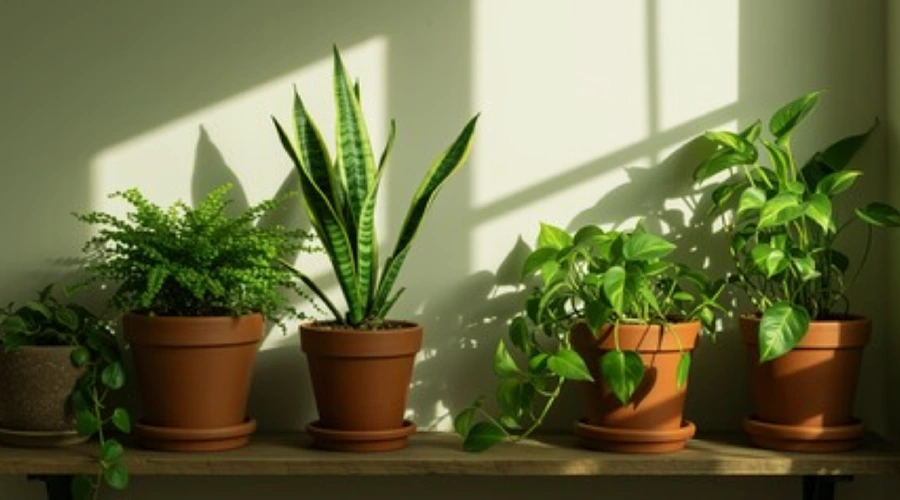
Quick Facts:
- Light: Tolerates low to bright, indirect light
- Water: Every 3–6 weeks (let soil dry completely)
- Difficulty: Very easy — almost unkillable
- Toxicity: Not safe for pets (mildly toxic if chewed)
Why it’s one of the best indoor plants:
Snake Plant is known as the “set it and forget it” houseplant. Even if you leave it alone for weeks, it will still stand tall with its sword-like leaves. That’s why it’s perfect for beginners, offices, and people who travel often.
Step-by-step care:
- Soil: Use a well-draining mix — cactus or succulent soil works best.
- Pot: Choose a pot with drainage holes to avoid water sitting at the bottom.
- Watering: Water thoroughly, then let the soil dry completely before watering again. In winter, once every 5–6 weeks is enough.
- Light placement: It can survive in low light (like a corner) but grows best in bright, indirect light. Avoid strong, direct sun as it can burn leaves.
- Fertilizer: Feed once in spring and once in summer with a balanced liquid fertilizer.
Common problems & fixes:
- Yellow leaves? Likely overwatering → let the soil dry.
- Wrinkled leaves? Too dry → water more regularly.
- Soft, mushy leaves? Root rot → cut affected leaves and repot in dry soil.
Propagation tip:
Snake Plants are easy to propagate. Simply cut a healthy leaf, let the cut end callus over 1 day, and place in water or soil. In a few weeks, you’ll see roots.
Placement idea:
Ideal for bedroom or corner-office greenery, it has the vertical structure of a plant, without the daily caring inconveniences. And the best part? – NASA once cited it as an air-purifying plant.
2. Pothos (Money Plant)
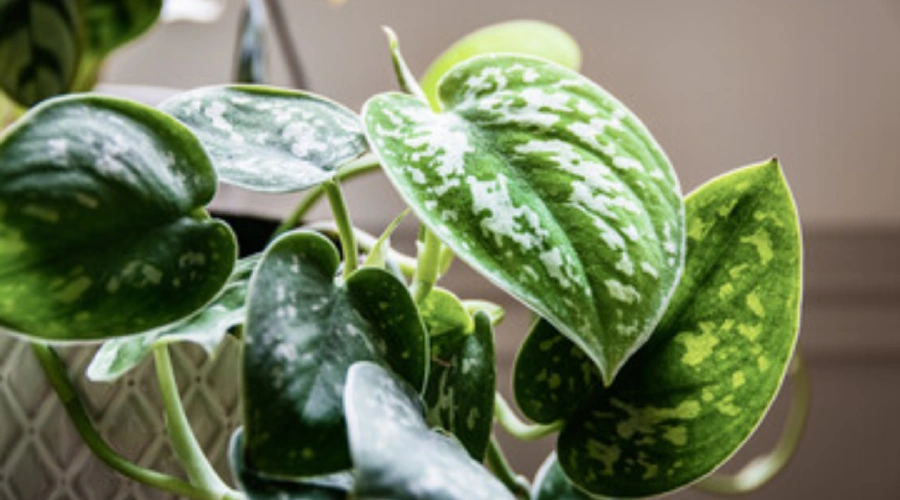
Quick Facts:
- Light: Prefers bright, indirect light but tolerates low light
- Water: Once the top 1–2 inches of soil feel dry
- Difficulty: Easy and fast-growing
- Toxicity: Not safe for pets (can cause irritation if eaten)
Why it’s one of the best indoor plants:
Pothos, typically known as Money Plant in many homes, is one of the most forgiving houseplant you can grow. With lovely heart-shaped leaves, it trails beautifully from pots and shelves. Pothos is a favorite to add greenscape in homes without much effort. Not only can you grow Pothos in water, but you can even grow it in soil, which is very versatile.
Step-by-step care:
- Soil: Regular potting soil with good drainage.
- Pot: Any pot, but make sure it has a drainage hole. Hanging pots or shelves really show it off.
- Watering: Water when topsoil feels dry. Don’t let roots sit in water. In winter, water a bit less.
- Light placement: Indirect sunlight is best. Too much direct sun will scorch the leaves, too much shade will slow growth.
- Fertilizer: Feed once a month during spring and summer with a diluted liquid fertilizer.
Common problems & fixes:
- Yellow leaves? Overwatering → let soil dry out.
- Leggy vines with fewer leaves? Not enough light → move to a brighter spot.
- Brown tips? Low humidity → mist the plant occasionally.
Propagation tip:
Take a stem cutting that contains at least 2-3 leaves. Put it in water or directly into the soil. The roots will form quickly, and you’ll have another plant to keep or give away.
Placement idea:
Looks fantastic in hanging baskets, on top of bookcases, or as a trailing plant in the kitchen. It adds an instant energetic feel to empty corners.
3. ZZ Plant (Zamioculcas zamiifolia)
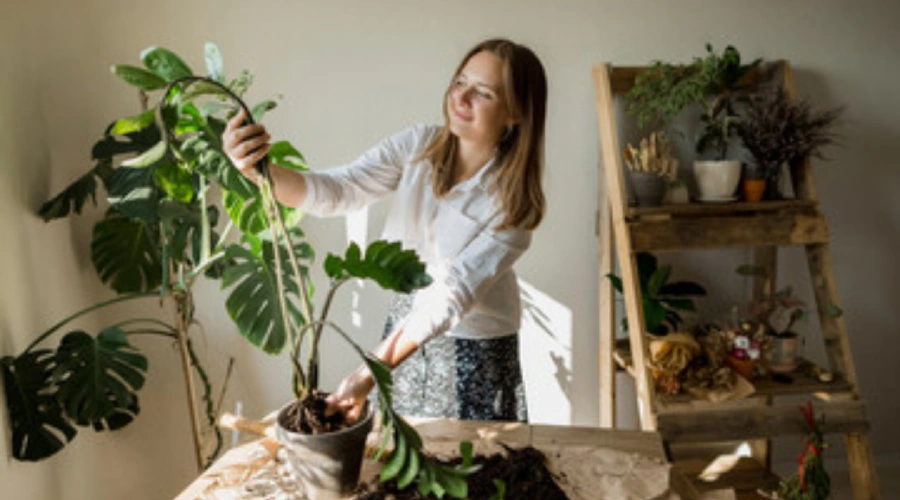
Quick Facts:
- Light: Low to medium, indirect light
- Water: Every 2–3 weeks (let soil dry in between)
- Difficulty: Very easy — thrives on neglect
- Toxicity: Not safe for pets (mildly toxic if chewed)
Why it’s one of the best indoor plants:
ZZ Plant is often called the “evergreen plant,” because it seems to thrive in almost any environment. With its glossy, deep green leaves, it always looks fresh and fashionable, even if it doesn’t receive much attention. ZZ is a godsend for anyone who forgets to water or has low light conditions.
Step-by-step care:
- Soil: Use a well draining potting mix; cactus mix works too.
- Pot: Choose a sturdy pot with drainage holes. ZZ roots grow slow so you won’t need to repot often.
- Watering: Water deeply, then leave it alone until the soil is dry. In winter, once a month may be enough.
- Light placement: It can tolerate very low light but grows best in bright indirect light. Don’t put it in direct sun or leaves will scorch.
- Fertilizer: Feed lightly once or twice during the growing season (spring and summer).
Common problems & fixes:
- Yellow leaves? Overwatering — ZZ hates wet soil.
- Wrinkled or curling leaves? It’s thirsty → give a good drink.
- Brown tips? Usually due to dry air — mist occasionally if your home is very dry.
Propagation tip:
The ZZ Plant can be propagated from leaf cuttings or by dividing its rhizomes (the thick potato-like structure seen at its roots). It takes a little time to grow, but the wait is well worth it.
Placement idea:
ZZ appears stunning in offices, hallways, or living rooms with very little light. For busy people, it’s simply a “set and forget” plant.
4. Spider Plant (Chlorophytum comosum)

Quick Facts:
- Light: Bright, indirect light (tolerates low light too)
- Water: About once a week, when the topsoil is dry
- Difficulty: Easy and fast-growing
- Toxicity: Safe for pets (non-toxic to cats and dogs)
Why it’s one of the best indoor plants:
Spider Plant is one of the loveliest house plants you can cultivate. With long, curving green and white striped leaves it appears so happy and carefree. Even better, it produces small “baby” plants (called plantlets) that hang on the mother plant like spiders on a web. How great is that for exchanging or propagating?
Step-by-step care:
- Soil: Houseplant mix with good drainage.
- Pot: Hanging baskets or pots on shelves.
- Watering: Water when top of soil feels dry. Likes evenly moist soil but not sitting in water.
- Light placement: Bright indirect light is best but Spider Plant can adapt to any corner. Avoid midday sun which can burn leaves.
- Fertilizer: Feed every 2-3 weeks in spring and summer with balanced liquid fertilizer.
Common problems & fixes:
- Brown tips on leaves? Fluoride or chlorine in tap water → use filtered water if possible.
- Leaves turning pale? Needs more light.
- Slow growth? Repot if roots are crowded.
Propagation tip:
Just cut the plantlets (baby spiders) off and plant them in fresh soil, or you can root them in water first. They put out a full plant fast!
Placement idea:
Spider Plants do best in hanging baskets in living rooms, kitchens, and even bathrooms (with the high humidity helping them out). They are pet safe too, so having them indoors is better for cats and dogs.
5. Peace Lily (Spathiphyllum)
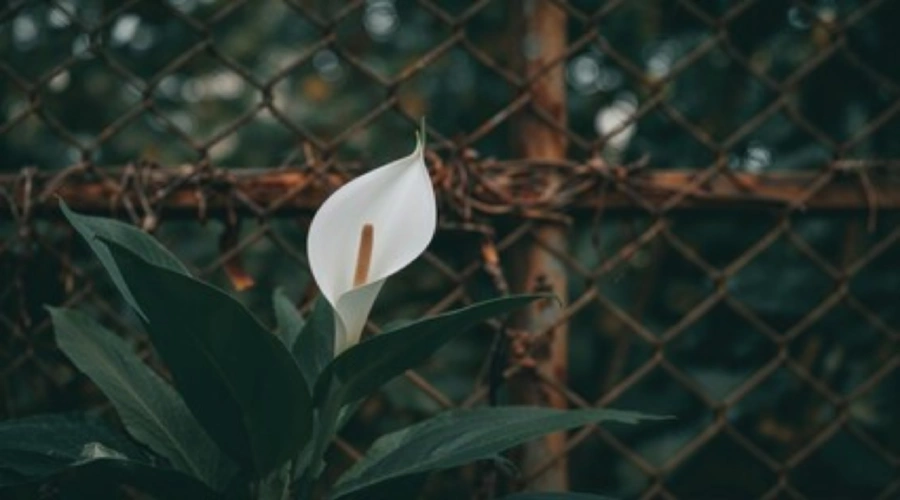
Quick Facts:
- Light: Medium to low, indirect light
- Water: Weekly; keep soil slightly moist
- Difficulty: Easy, beginner-friendly
- Toxicity: Not safe for pets (toxic if eaten)
Why it’s one of the best indoor plants:
Peace Lily is a popular choice for beginner indoor plant people, not just because it’s leafy, but because it blooms indoors! Its striking white flowers stand out beautifully against glossy green leaves and they instantly create a calm, clean feel for your home. What’s more, Peace Lilies are also great natural air purifiers.
Step-by-step care:
- Soil: Good quality potting mix.
- Pot: Medium pot with holes.
- Watering: Peace Lilies like soil slightly moist. Water once a week, don’t let them sit in water. If the leaves droop, it’s a sign they need water — water and they’ll bounce back quickly.
- Light placement: Medium or low indirect light. Avoid direct sunlight, it will scorch the leaves.
- Fertilizer: Feed every 6 weeks in spring and summer with balanced liquid fertilizer.
Common problems & fixes:
- Yellow leaves? Too much light or overwatering.
- Brown leaf tips? Low humidity or too much fertilizer.
- No blooms? Needs more light or a little fertilizer.
Propagation tip:
Peace Lilies grow in clumps, so it’s best to propagate by dividing the plant at the time of repotting. Just take a clump with roots and pot it on its own.
Placement idea:
Ideal for living rooms, bedrooms, or shady corners. A blooming Peace Lily creates a lovely, calming vibe, they look especially nice near entryways.
Also Read: Easy to grow woody plants for small gardens
6. Aloe Vera
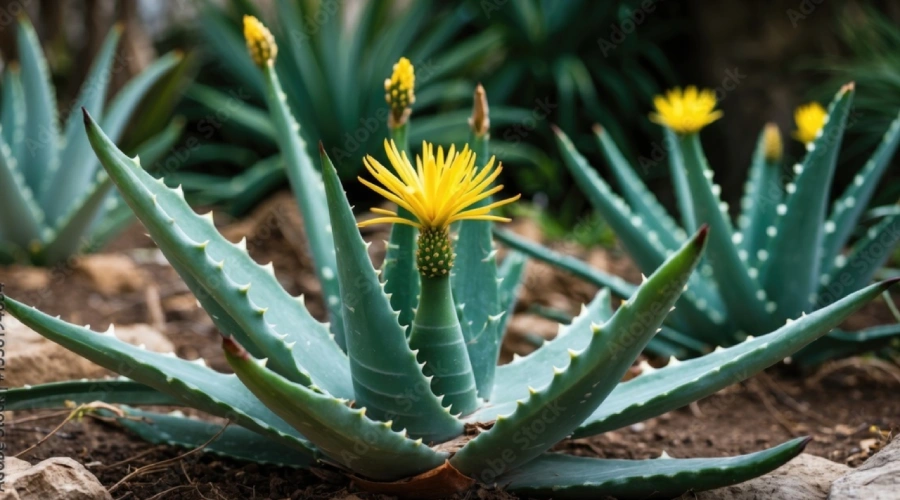
Quick Facts:
- Light: Bright, indirect sunlight (can handle some direct sun)
- Water: Every 2–3 weeks; let soil dry completely
- Difficulty: Easy, beginner-friendly
- Toxicity: Not safe for pets (toxic if ingested)
Why it’s one of the best indoor plants:
Aloe Vera is not just a pretty succulent; it is also a tiny first-aid kit. The gel within the thick leaves can medically help burns, cuts, and skin irritation. In addition, it is easy to care for and thrives on neglect- great for beginners not wanting to worry about everyday care.
Step-by-step care:
- Soil: Employ a cactus or succulent mix – it’s quick draining and will help maintain healthy roots.
- Pot: Terracotta pots with holes suited to drainage are best, as they allow excess water to evaporate.
- Watering: Water thoroughly but infrequently. Let the soil completely dry out before watering again. In winter, even less.
- Light placement: Place it near a bright window – either south or west is best. Don’t keep it in dark corners.
- Fertilizer: Feed once in spring and once in summer using a diluted succulent fertilizer.
Common problems & fixes:
- Leaves turning brown or mushy? Overwatering → repot in dry soil and reduce watering.
- Leaves turning thin and curling? Plant is thirsty → water thoroughly.
- Leaves getting sunburned? Too much direct sunlight → move to indirect light.
Propagation tip:
Aloe grows “pups” (small offshoots) at the base of the plant. During repotting, separate these from the original plant and individually pot them to create new Aloe plants.
Placement idea:
Looks amazing on a bright and sunny windowsill, kitchen countertop, or balcony table. Plus it is also functional – you can cut a leaf and use the gel for minor skincare.
7. Areca Palm (Dypsis lutescens)
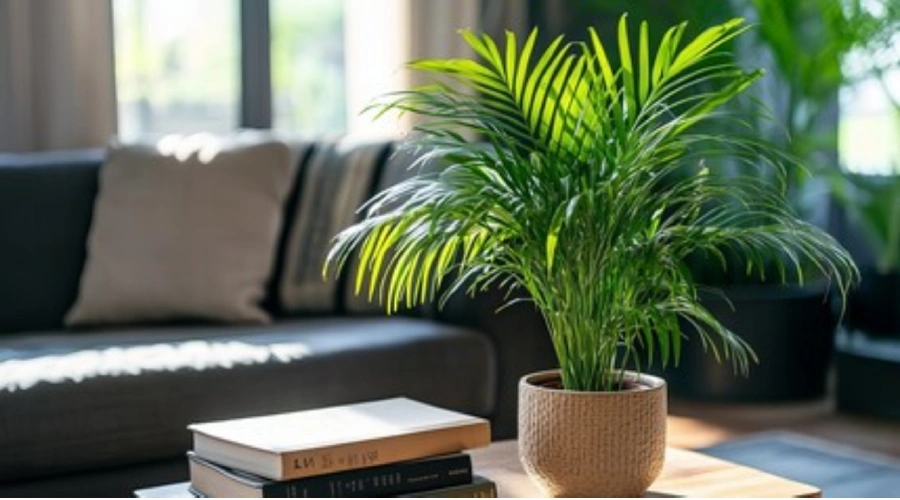
Quick Facts:
- Light: Bright, indirect light
- Water: Once a week; keep soil slightly moist
- Difficulty: Moderate (needs a bit more care)
- Toxicity: Safe for pets (non-toxic to cats and dogs)
Why it’s one of the best indoor plants:
If you are looking for that fresh, tropical feel in your living space, the Areca Palm is definitely a great option. This plant has soft, feathery, arching fronds which adds an air of sophistication and provides a calming ambiance to the space. This palm is pet friendly, therefore a great plant for homes with cats or dogs.
Step-by-step care:
- Soil: Use a quality potting mix that drains well, if possible, mix in some sand or perlite to help drainage.
- Pot: Use a deep pot with drainage holes, because Areca Palms grow multiple stems.
- Watering: Keep the soil evenly moist, but never soggy. Water once a week, and reduce in the winter months.
- Light placement: It does best with bright, indirect light. Direct sunlight can scorch the fronds, and limited light will slow growth.
- Fertilizer: Feed once a month during the spring and summer with a diluted liquid fertilizer.
Common problems & fixes:
- Brown leaf tips? Usually from dry air → mist the leaves regularly.
- Yellowing fronds? Could be from too much water → allow the soil to dry slightly before watering again.
- Slow growth? Needs more light or a bigger pot.
Propagation tip:
Areca Palm is generally propagated by dividing the clumps during repotting. With areca palms, you gently separate some stems with roots intact for repotting.
Placement idea:
It looks beautiful in a living space, a hallway, or next to a sofa where its fuzzy leaves can spread out. Since it is pet-safe, it can be placed anywhere and you don’t have to worry if a pet gets into it.
8. Monstera (Monstera deliciosa)

Quick Facts:
- Light: Bright, indirect light
- Water: About once a week; let the topsoil dry first
- Difficulty: Moderate (needs space and light)
- Toxicity: Not safe for pets (toxic if chewed)
Why it’s one of the best indoor plants:
Monstera, also known as the Swiss Cheese Plant, is well-known for its large, shiny leaves which have natural holes in the leaves. This plant brings a dramatic tropical look to your home. With the right care, the Monstera is fast-growing. This plant makes a statement in your living space — an excellent choice if you are looking to have something that stands out.
Step-by-step care:
- Soil: Chunky, well draining mix — potting soil with perlite or orchid bark works.
- Pot: Medium to large pots with drainage holes because Monstera gets big.
- Watering: Water when the top 2 inches of soil are dry. Make sure excess water drains out.
- Light placement: Bright, indirect light. Too much direct sun will scorch leaves, too little light will slow down the leaf splitting.
- Fertilizer: Feed every month during the growing season (spring and summer) with a balanced fertilizer.
Common problems & fixes:
- Yellow leaves? Overwatering — let soil dry more between waterings.
- Drooping leaves? Thirsty — give a deep soak.
- Leaves not splitting? Plant may be too young or not getting enough light.
Propagation tip:
Cut a healthy stem with at least one node and an aerial root. Place in water or moist soil until roots develop, then pot up.
Placement idea:
Monstera is perfect for large living room corners or beside furniture where its big leaves can shine. Add a moss pole and it will grow taller.
9. Rubber Plant (Ficus elastica)

Quick Facts:
- Light: Bright, indirect light (can handle some morning sun)
- Water: Every 1–2 weeks; let topsoil dry before watering again
- Difficulty: Moderate — needs steady conditions
- Toxicity: Not safe for pets (toxic if ingested)
Why it’s one of the best indoor plants:
Rubber Plants are recognized for their broad, shiny leaves which can instantly add a fashionable, modern look to your room. When well cared for, they can grow tall which makes them an excellent choice to achieve a leafy, indoor tree-like plant.
Step-by-step care:
- Soil: Well-draining potting soil is essential; adding perlite or sand can help.
- Pot: A sturdy pot is very important because Rubber Plants can become quite heavy, and have drainage holes.
- Watering: Water when the top 1–2 inches of soil feel dry. The plants like the soil a little moist, but not and don’t water if the soil feels soggy. In winter, water less.
- Light placement: These plants do well in bright, indirect light. Morning sun is fine, just keep them out of any harsh afternoon sunlight.
- Fertilizer: Feed every month in spring and summer with a balanced fertilizer.
Common problems & fixes:
- Yellowing leaves? Often from overwatering → let soil dry more.
- Dropping leaves? Sudden changes in light or temperature. Keep it steady.
- Dull, dusty leaves? Wipe leaves with a damp cloth to keep them shiny.
Propagation tip:
Take a stem cutting with one leaf on it. Dip the cut end in rooting hormone and place it in moist soil. You can keep it in a plastic bag to keep the humidity up until roots start to form.
Placement idea:
Rubber Plants are beautiful when used as a floor plant in a living room or office. Their bold leaves create an incredible statement and look good in spaces with filtered windows.
10. Chinese Evergreen (Aglaonema)

Quick Facts:
- Light: Low to medium, indirect light
- Water: Every 1–2 weeks; allow soil to dry slightly between waterings
- Difficulty: Easy — very beginner-friendly
- Toxicity: Not safe for pets (toxic if eaten)
Why it’s one of the best indoor plants:
The Chinese Evergreen is often called a “set-and-forget” plant. It’s one of the easiest houseplants to grow and it tolerates low light better than most. The leaves come in beautiful, varied patterns of green, silver, and sometimes red, making it both decorative and hardy.
Step-by-step care:
- Soil: Use a medium potting soil that has good drainage. You can also add some perlite to keep roots nice and healthy.
- Pot: You will want a medium size pot that has drainage holes.
- Watering: Water when the first inch of soil dries out. They do not like soggy soil, that’s all they care about. In Winter you will want to water it much less.
- Light placement: Low to medium light is perfectly fine. They adapt well to the office and even to darker corners, just avoid direct sun.
- Fertilizer: Use a balanced fertilizer every 6-8 weeks in spring and summer.
Common problems & fixes:
- Yellow leaves? Overwatering → let soil dry out.
- Brown edges? Usually from dry air → mist the leaves occasionally.
- Slow growth? It may need more light — move closer to a window.
Propagation tip:
The best way to propagate Chinese Evergreen is by division. When you repot your Chinese Evergreen, just separate a clump with its roots, and pot it separately.
Placement idea:
Ideal for offices, bedrooms, or hallways where little light reaches. The patterns on the leaves will give color and life to even the darkest corners.
Micro-Guides for Indoor Plant Care
1. How to Water Indoor Plants the Right Way
Watering is the number one reason most beginners kill their plants — too much or too little. The secret is simple: don’t water on a schedule, water when the plant needs it.
- Check the soil: Stick your finger 1–2 inches into the soil. If it feels dry, it’s time to water. If it’s still damp, wait a few more days.
- How to water: Water slowly until it drains out of the bottom hole. Empty the tray so roots don’t sit in water.
- Bottom watering trick: Place the pot in a shallow tray of water for 15–20 minutes. The roots soak up what they need.
- Seasonal difference: In winter, plants drink less. Always reduce watering during cold months.
👉 Rule of thumb: It’s better to underwater than overwater. Most indoor plants can bounce back from dryness, but root rot from soggy soil is often fatal.
2. Choosing the Right Soil
Soil isn’t just “dirt” – it is the plant’s home. There is a risk of root suffocation or too much water if you use the wrong soil.
- General houseplants (Pothos, Peace Lily, Rubber Plant): Regular indoor potting mix.
- Succulents, Aloe, Jade, Snake Plant: Cactus or succulent mix will drain faster and help dry roots.
- Tropical plants (Monstera, Areca Palm, Calathea): Chunky mix with perlite/orchid bark allows for airflow around roots.
👉 Quick DIY potting mix for most plants:
- 2 parts potting soil
- 1 part perlite or sand (for drainage)
- 1 part coco coir or peat moss (for moisture balance)
3. Understanding Light for Indoor Plants
“Bright indirect light” is one of the most common care instructions, but what does it actually mean?
- Direct light: Light from the sun hits the plant directly (like on a sunny windowsill). Ideal for succulents and Aloe.
- Bright, indirect light: This light situation occurs near a window but it is covered by curtains or a couple of feet away from the window. Great for most houseplants.
- Low light: This situation is a good distance away from windows or in corners where the sun does not hit. Only a few plants thrive in low light conditions like Snake Plant or ZZ Plant.
👉 Simple test: Position your hand in the spot where the plant will go.
- Sharp, distinct shadow = direct sunlight
- Soft, fuzzy shadow = bright indirect light
- Faint or no shadow = low light
4. Humidity and Temperature Basics
Most indoor plants come from tropical regions so they love warm air and a bit of humidity.
- Temperature: Most happy between 18–28°C (65–82°F). Avoid cold drafts and sudden temperature changes.
- Humidity:
- High humidity lovers: Calathea, Peace Lily, Areca Palm. Mist them or group them with other plants.
- Low humidity tolerant: Snake Plant, ZZ Plant, Succulents — they’re fine in drier air.
- Cheap humidity hacks:
- Place a tray of water with pebbles under the pot (but don’t let roots touch the water).
- Group plants together — they naturally share moisture.
- Use a humidifier if your room is very dry.
👉 Signs of low humidity: crispy leaf edges, curling leaves or brown tips.
✅ These micro-guides make caring for the best indoor plants less of a mystery. They’re simple rules you can follow no matter which plant you choose.
Buying & Shopping Tips for Indoor Plants
When you’re ready to start your journey as a plant parent, the next big question is: Where do I buy my plants and how do I pick the right ones? Here are some basic tips to ensure that you bring home plants that will be healthy and last a long time.
1. Local Nurseries vs. Online Stores
- Local nurseries:
- Advantage: You can see the condition of the plant in person.
- Staff usually give care instructions based on your home environment.
- The plants are likely to be acclimated to your local climate.
- Online stores:
- Advantage: Huge selection, even rare plants.
- You can’t beat it for convenience — to your door!
- Read reviews and read their return policies before you buy.
👉 Tip: If you are a novice, start with a visit to your local nursery. You will get a lot more out of the experience by asking questions face to face.
2. How to Choose a Healthy Plant
When you are in the shop, you will want to examine the following for a few minutes:
- Leaves – Should be green and firm with no yellow or brown spots.
- Stems – Should have no mushy or black stems (a sign of rot).
- Soil – Should not be soggy, and should not smell bad – this usually means there are root problems.
- Pests – Look carefully on the undersides of the leaves and in the soil for tiny insects, webs, or white cotton-like patches.
- Roots – If there are roots sticking out of the bottom holes of the pot, the plant is probably going to need to be repotted very soon (which is not a dealbreaker, just nice to know).
3. Transporting and Settling Plants at Home
- Transport carefully: Keep the plant upright during transport. Don’t leave it in a hot car.
- Quarantine new plants: Keep new plants separate for 7-10 days before putting them with your other plants. This stops any hidden pests from spreading.
- Acclimate slowly: If you bought a plant that was grown in a greenhouse, it may need time to adjust to your home’s light and humidity. Don’t stress if you see a leaf or two go yellow — it’s just settling in.
✅ Buying the right indoor plants isn’t just about picking the prettiest one on the shelf. By checking leaves, soil and roots and giving your new plant time to adjust at home, you’ll be set up for success from day one.
Conclusion: Bring Home the Best Indoor Plants
Starting with indoor plants doesn’t have to be hard. Choose the best indoor plants for beginners — like Snake Plant, Pothos, ZZ Plant or Spider Plant — and you can have greenery without the stress. If you want something bold, Monstera or Rubber Plant will make a statement, Peace Lily and Calathea will add elegance and softness. And if you’re short on time or space, succulents and Jade Plant are low-maintenance.
Remember, the secret to happy plants is simple: give them the right light, don’t overwater and keep an eye on their leaves. With a little care your plants will reward you with fresh air, beauty and a calm atmosphere at home.
Frequently Asked Questions (FAQ) About Indoor Plants
What are the easiest indoor plants for beginners?
Snake Plant, Pothos, ZZ Plant, and Spider Plant are the easiest because they need very little care and survive even if you forget to water sometimes.
How often should I water indoor plants?
Most indoor plants need watering once the top 1–2 inches of soil feel dry. Always check the soil before watering instead of following a fixed schedule.
Which indoor plants are safe for pets?
Spider Plant, Areca Palm, and Calathea (Prayer Plant) are non-toxic and safe for cats and dogs. Always double-check if you have pets at home.
Do indoor plants really clean the air?
Yes, plants like Snake Plant, Peace Lily, and Areca Palm can improve air quality by filtering toxins. But remember, they work best as part of a clean, ventilated home — not as the only purifier.
Why are my plant’s leaves turning yellow?
The most common reason is overwatering. Other causes include poor drainage or not enough light. Check the soil and adjust care accordingly.
Can indoor plants grow without sunlight?
Not completely. Some plants like Snake Plant, ZZ Plant, and Chinese Evergreen tolerate low light, but all plants need some indirect light to stay healthy.
How do I know when to repot my indoor plant?
If roots are growing out of the bottom hole, the plant looks too big for its pot, or water drains too quickly, it’s time to repot into a slightly bigger container.
What’s the best soil for indoor plants?
Most houseplants do well in regular potting mix with added perlite for drainage. Succulents and Aloe need cactus soil, while tropical plants like Monstera love a chunkier mix.

